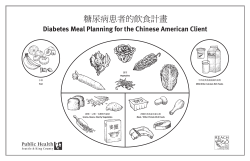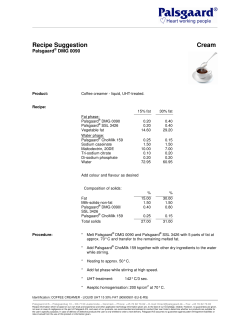
Healthy weight How to achieve and maintain a healthy weight
Healthy weight How to achieve and maintain a healthy weight Making changes to your eating habits and becoming more active can get you on track to achieving a healthy weight Eating for a healthy weight To achieve a healthy weight, it is recommended you enjoy a balanced diet and regular physical activity. The Eatwell plate gives you a guide to help you plan what to eat. The Eatwell plate All foods can be part of a healthy diet, but it’s the right balance and variety that is important for health. The Eatwell plate (below) shows the proportions needed for a healthy balanced diet. Foods from the largest groups should be eaten most often. Fruit and vegetables Bread, rice, potatoes, pasta and other starchy foods Bread, rice, potatoes, pasta and other starchy foods These foods provide you with energy, are low in fat and should be included at each meal. To keep these foods low in fat: ● use skimmed or 1% fat milk on wholegrain cereals or porridge oats ● use spreads sparingly on bread and toast ● try tomato-based sauces instead of creamy sauces to serve with pasta ● enjoy boiled plantain, or potatoes, sweet potatoes and yams in their jackets, boiled or mashed rather than chipped or roasted in oil. Fruit and vegetables Meat, fish, eggs, beans and other nondairy sources of protein Milk and dairy foods Foods and drinks high in fat and/or sugar To ensure you get all the nutrients your body needs, you need to eat some food from each of the food groups every day. Foods from the largest groups should be eaten most often. Adapted from the Eatwell plate in discussion with the Food Standards Agency. The Eatwell plate is suitable for all adults and children over the age of 5. These are low in fat and calories. Aim for a variety of 5 portions a day. ● They make a quick, low-calorie snack. ● Fresh, frozen, dried and canned all count towards your 5-a-day, as does fruit juice. ● Fill up on vegetables or salad and limit dressings and sauces. ● Look out for the 5-a-day symbol. What’s a typical portion? 1 whole fruit (eg apple); a handful of grapes; a cereal bowl of salad; 2 small fruits; 3 heaped tablespoons vegetables; 150ml glass of 100% juice; 1 heaped tablespoon dried fruit. Dried fruit and fruit juice are a concentrated source of calories, so keep to 1 portion a day. Meat, fish and alternatives (lentils, pulses, eggs, nuts) 1A-DAY OF5 Y These are a great source of protein, iron and other minerals. Eat in moderation. ● Take the skin off chicken and trim any visible fat off meats before you cook them. Fruit and vegetables Dairy foods d Meat, fish an alternatives ● Use low-fat cooking methods such as grilling, stir-frying, boiling or steaming. ● Include canned or dried lentils and pulses (like beans or chick peas) in curries and stews as an alternative to meat as they are a great source of fibre and are low in fat. ● Limit high-fat meat products such as sausages, mince and processed meats. ● Choose canned fish in brine, spring water or tomato-based sauces instead of oil. What’s a typical portion? 80g cooked lean red meat or poultry; 100–150g cooked white fish or oily fish*; 1–2 eggs; 3 tablespoons beans, pulses or lentils; 2 tablespoons peanut butter or nuts. Milk and dairy foods These are a rich source of calcium and one of the easiest ways to achieve your daily calcium requirements is to consume 3 portions. ● Choose low-fat varieties – look out for our be good to yourself range. ● Try semi-skimmed, 1% fat or skimmed milk. ● Try lower-fat cheeses such as ricotta or cottage cheese. ● Snack on low-fat yogurt with chopped fruit. ● Use plain yogurt instead of cream in recipes. What’s a typical portion? 200ml glass of milk; 150g pot of yogurt; 30g hard cheese; 2 tablespoons cottage cheese. Foods and drinks high in fat and/or sugar Reducing foods high in fat and sugar, such as crisps, biscuits, cakes, pies, chocolate, sweets and soft drinks, can help you manage your weight. ● Swap mayonnaise, salad cream and oil-based dressings for fat-free or reduced-fat varieties – try vinegar with lemon or lime juice. ● Snack on fruit, low-fat yogurt or a currant bun. ● Use less oil in cooking – try using oil sprays and non-stick frying pans. Alcohol and weight loss Alcohol contains a lot of calories and provides you with few nutrients, so be aware of how much you are drinking. Should I be cutting out bread, rice, potatoes and pasta? No. These foods are relatively low in calories and can fill you up. But adding creamy sauces, lots of butter, margarine or oil, or deepfrying potatoes, increases fat and calorie content, which could result in weight gain. *Women of child-bearing age should not eat more than 2 portions of oil-rich fish per week as they can contain high levels of chemicals called dioxins. Cutting calories and fat Reducing calories is easier than you think – it’s just a matter of being smart with your food choices. These simple food swaps will help save on calories, fat and saturated fat. Mealtime Breakfast Mid-morning snack Lunch Afternoon snack Swap this… ✗ white toast and butter ✗ chocolate rice pops and full-fat milk ✗ a full English breakfast √ wholemeal bread and low-fat spread √ wholegrain cereal and semi-skimmed or 1%-fat milk √ grilled bacon, mushrooms, tomatoes and poached egg ✗ chocolate bar hh ✗ bag of crisps ✗ slice of chocolate cake √ reduced-fat or less than 3% fat cereal bar √ rice cakes with low-fat soft cheese √ toasted teacake with low-fat spread ✗ jacket potato with cheese and beans ✗ BLT sandwich on white bread ✗ chicken Caesar salad hhh ✗ macaroni cheese √ jacket potato with tuna or prawns with light mayonnaise and salad √ ham salad sandwich on granary or wholemeal bread √ grilled chicken salad with low-fat, or reduced-fat dressing √ pasta with a tomato-based sauce ✗ chocolate biscuits vv ✗ salted nuts √ less than 3% fat or reduced-fat digestive biscuit √ raw vegetable sticks with less than 3% fat houmous ✗ fish and chips √ grilled salmon, new potatoes and steamed vegetables √ make your own curry using yogurt for the sauce, chicken breast and plenty of vegetables ✗ chicken curry and rice Evening meal For this… ✗ spaghetti bolognese √ use extra-lean mince and bulk it up with extra vegetables How to read a label Cooking with less fat Investing in some healthy cooking equipment can make a positive difference to your diet. Using a non-stick frying pan or wok is a good way to cut down on fat as you do not need extra oil for cooking. When you do need some, try oil sprays to reduce the amount of oil you use. Remember, oil expands when it’s heated, so you may not need as much as you think. Using a tablespoon as a measure is a good 1 2 way to control how much you use. Try some lower-fat cooking methods such as poaching, Contains nuts, milk and wheat gluten. Not suitable for sesame, egg or soya allergy sufferers due to manufacturing methods. steaming, grilling and stir frying. Also, marinades are a good way to add extra flavour without adding extra fat. Sainsbury’s traffic-light nutrition labelling on the front of cal fat 564 21.1g food and drink tells you at a total sat fat sugars glance if the 9.6g salt 9.5g food has high 1.10g (red), medium 20mm 16mm ⁄ a pack (amber) or low (green) amounts of fat, saturated fat, Allergy advice Allergy advice salt, sugar and calories. To make a healthier choice, go for more greens and ambers, and fewer reds. Contains nuts, milk and wheat gluten. Great to know Nutrition Typical values GDA per 100g per 1/2 pack % adult GDA Energy kJ 624 Energy kcal 1128 Protein nil Carbohydrate 129.6g of which sugars 19.2g Fat 42.2g of which saturates 19g Fibre 5.8g Salt 2.20g of which sodium 0.12g 317 564 nil 64.8g 9.6g 21.1g 9.5g 17.4g 1.10g 0.36g per 1/2 pack (150g) 25.3% 0.0% 9.9% 23.4% 15.3% 26.8% 72.5% 21.0% 15.0% adult children (5-10 yrs) 2000 45g 230g 90g 70g 20g 24g 6g 2.4g 1800 24g 220g 85g 70g 20g 15g 4g 1.4g GDAs = Adult Guideline Daily Amounts are based on an average female. GDAs are guidelines and personal requirements vary depending on age, gender, weight and activity levels. Nutritional know-how The nutrition panel on the back of the pack can help you make sure you enjoy a balanced diet. It shows the amount of different nutrients per 100g of the product – where space permits, we also give this information per serving. We have used the traffic-light colour coding for the nutrition panel. You’ll also find Guideline Daily Amounts (GDAs) on products. These guides show the daily amount of nutrients the average adult or child (5–10 years) should have in their diet. They show what percentage of your GDA is in a portion, and the nutritional contribution it makes to your diet. Healthier options We have plenty of great-tasting healthier products for you to choose from at Sainsbury’s. Simply look out for our be good to yourself range, which has strictly controlled levels of fat, saturated fat, sugar and salt – all products in the range are either less than 3% fat or reduced fat. When shopping, look out for other healthier products marked as low fat, low saturated fat, reduced fat, light and half fat. Ask your Sainsbury’s pharmacist Please talk to our friendly pharmacists instore if you or your family need any healthcare advice or support. Our pharmacies have extended opening hours and are in most of our larger stores. How do you shape up? Being overweight increases your chances of heart disease and high blood pressure as well as many other health problems. To find out if you need to lose weight, measure your waist. European men with a waist greater than 94cm (37in), Asian men with a waist greater than 90cm (36in) and women with a waist greater than 80cm (32in) should take steps to reduce their weight. Customers will be able to take advantage of up-to-date nutrition news, the extensive database of Sainsbury’s recipes, a free body shape toning plan and lots of useful tools and calculators, as well as mobile access. Members will also have access to our discussion forums, where they can share stories and get support from the online community. For more information, visit sainsburysdiets.co.uk. Healthier recipe ideas To inspire you to cook healthily, we have 100s of recipes on our website and our recipe cards instore include our traffic-light labelling – try the ones that have green and amber traffic lights for a delicious, healthier choice. Online dieting Sainsbury’s Diets is a subscription-based online diet service that aims to help you lose weight in a controlled and responsible way. It offers personalised meal plans and a convenient food diary service. Useful websites For information on healthy weight loss, visit Weight Wise: www.bdaweightwise.com For information on healthy eating, visit the British Dietetic Association: www.bda.uk.com For information on eating well, visit the Food Standards Agency: www.eatwell.gov.uk For information on nutrition and health, visit www.sainsburysdiets.co.uk This information is a guide only and should not replace advice given by your healthcare professional Sainsbury’s Supermarkets Ltd, 33 Holborn, London EC1N 2HT. All items subject to availability. Some items available in larger stores only.
© Copyright 2025










